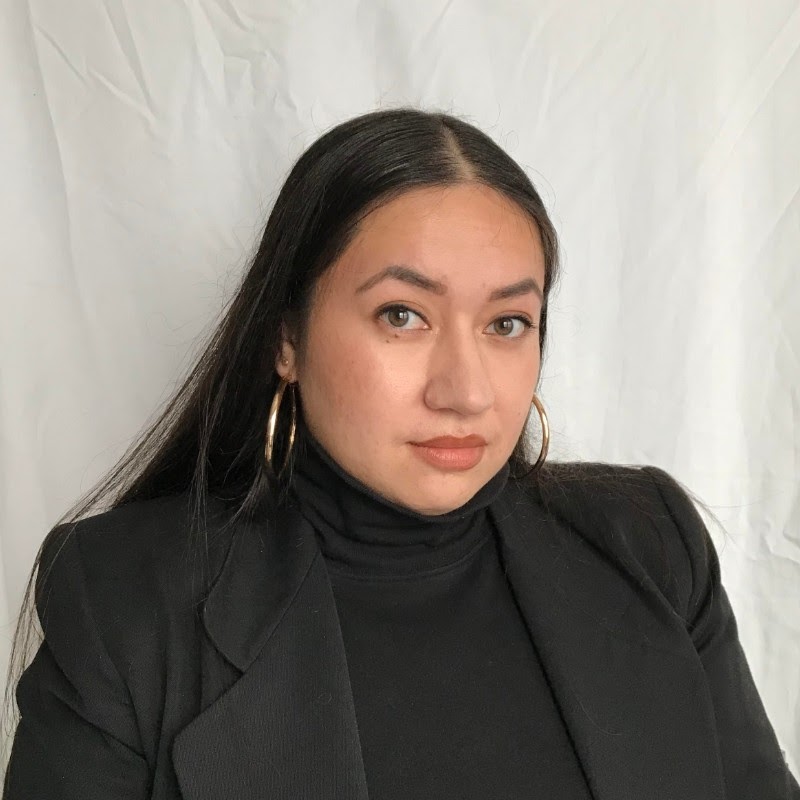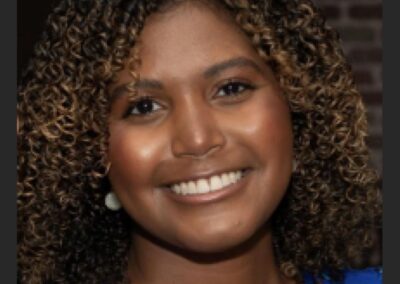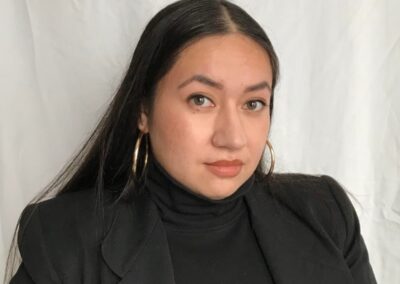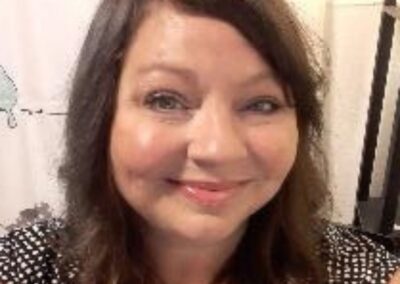She/Her
I interviewed seven Douglas County Community members with various intersecting identities— folks of color, trans-femme and queer folks, women—with the majority of community members interviewed identifying as BIPOC (Black, Latinx, Asian). It is an honor to uplift their voices and stories.
As I was meeting with my interviewees, there were all shared emotions of concern, worry, but also hope for change. Folks want to see change in the Lawrence Community around climate, and committed to seeing the Lawrence Community and Community Leaders create policy rooted in action to address climate change in Douglas County.
Ideas, thoughts, and themes from Lawrence Community Members to highlight:
- Shift from usual extreme weather in expected places, to extreme weather/change in unexpected places
- “So I feel like for the region, I’m like, kind of used to expect a certain amount of like extreme weather. But I feel like what’s shifted from my observation is like, the places that we can expect it are changing… Yeah, the weather is changing, but like it’s affecting areas that like aren’t used to it.”
- Reimagining, cultivating and developing green spaces in Douglas County/Lawrence
- “More paths, bike paths, that allow folx to take different modes of transportation around the city”
- “I feel like I mean, the practical approach for the city would definitely be to like plant more trees. Like reduce these like you know, like the amount of radiant heat that we’re getting from the asphalt and the concrete. But I feel like growth is also something that’s like important for our cities. We need to consider how we’re going to like, incentivize and like facilitate, like, growth in the right ways. Like how are we going to like, grow and like keep our town healthy without like dumping concrete all over everything. And like, are there tax incentives we can like offer people or like the type of credits that we can offer people to like, help them because also we need to like preserve the things that we have. So I don’t know like what the answer is but I know that it’s like multi-pronged. It has to like we have to change the way we’re doing things and then we also have to like preserve what we have, because I definitely don’t think that like tearing things down is the answer either.”
- How do we make more neighborhoods walkable?
- Engage more with nature and the outdoors, use less motarized vehicles
- Conservation of green space in residential developments
- When developments are being created
- Replanting
- Reenergizing area that was moved and disturbed
- Ask developers to contribute to a prairie tax, contribute to allow prairies to thrive.
- “Another thought that I have is like, right, KU is this massive entity and like a huge economic influencer in Lawrence. I just saw a statistic from the GTAC, which is the Graduate Teacher Assistants Coalition. KU spends more money on landscaping than they spend collectively on the salaries of grad assistants. And like, like I’m thinking again. . . I’m the Assistant Director of the Office of Multicultural Affairs, and we have these little two garden beds, that we could easily be growing food and we could easily partner with folks like Panta Leon, who is an indigenous farmer, we could easily be growing free food for the community. Students could be getting community service hours for that it could be a win-win-win. There’s so much like just excess like grass on KU campus that we could be turning into accessible community gardens that we could be getting people into since there are bus routes at KU. I think tapping into KU as a resource and asking like, how can KU give back to our community would be huge.”
- “I’m still on this idea of like, like Mass Street we pride ourselves on quote, unquote, local businesses being here. It’s a lot of chains.But like all the flower beds that we have all of like the young trees that we plant, we can easily plant fruit trees. We can easily be planting sweet potato plants, zucchini plants for folks to take, but we’re focused on the aesthetic. All the fucking Christmas lights that we have up for the next two months. Are they on solar power? What are we doing to access that? Are there any solar power or alternative energies that we use on Mass Street, which is like a hub of people?”
- Reimagining structures to be more environmentally efficient/community spaces
- “Yeah, like I know this girl in New Mexico who’s like working for an architecture firm and the firm like, helps homes and businesses become more environmentally efficient. So they don’t actually construct new buildings, they just like make existing structures as energy-efficient as possible. And that seems like a really like good thing to be doing right now.”
- Reuse and repurpose old buildings that are not being used
- How to do we make this a community project to revitalize space for community use?
- Ex. Chelsea Highline in NYC
- Are their accessible climate shelters for folks when experiencing extreme weather? Year-round?
- Investment in Renewable Energy for the Community
- “I’m still on this idea of like, like Mass Street we pride ourselves on quote, unquote, local businesses being here. It’s a lot of chains. But like all the flower beds that we have all of like the young trees that we plant, we can easily plant fruit trees. We can easily be planting sweet potato plants, zucchini plants for folks to take, but we’re focused on the aesthetic. All the fucking Christmas lights that we have up for the next two months. Are they on solar power? What are we doing to access that? Are there any solar power or alternative energies that we use on Mass Street, which is like a hub of people?”
- What sustainable energy could Douglas County invest in? We have the water plant, but what about solar and wind energy?
- Energy bills being more regulated
- Concern over rising energy bills due to hotter and colder temperatures, rolling blackouts/negative cold snap January 2021
- Heightened allergies like never before
- Transportation and Public Transportation was mentioned in every interview except one, and was an important thread connecting folx. Folx want to see improved public transit that is more reliable, has enclosed shelters to protect folx from the weather (shade for heat, cover for rain/snow, cover from wind, etc. instead of a bench or sole sign).
- “I would say a bigger influence on public transit for sure from both of us going to KU and having that the transit of that small little bubble of getting anywhere and everywhere we needed to from where we were living close to campus, being the ease of going back and forth between home and school. And then it seemed like the difference between that and then the rest of the whole city because it is a college town so not everyone can afford to just pay for parking on campus. So making sure that’s taken care of because it’s not just a problem for students. It’s a problem for everyone who lives in the county and especially in the Lawrence area. It’s like a right to be able to have safe and effective public transportation.”
- “I would love to see people like really investing more into the bus routes, because the bus routes really revolve around the students but staff and working people still need those buses in the summer in the winter. If we had stronger bus routes I know I wouldn’t be using my car as much if we had reliable community transportation… I do like that Lawrence is like walkable and a lot of ways, in theory. Yeah, like downtown is walkable. But as somebody who didn’t have a car the first year that they lived in Lawrence, it’s not accessible. So that’s like very abelist, like the sidewalk just runs out and they got to backtrack.”
- “We’re taking the fully enclosed ones down [bus stops]. I’ve noticed weird, trendier benches where it really just seems like it’s targeted at people affected by homelessness. Yeah. Taking away any protection from the elements that they might have. Just to have something that just like, doesn’t offer anything besides a bench. Yeah, it really doesn’t seem like it’s aimed at being a useful thing for people it really just seems like it is supposed to be targeted toward the most affected by wealth inequality here and then like if you’re using for public transportation for the most part, it’s like you’re not doing this because you want to it’s really your only option to be able to get around and then yeah, having you sit in the heat cold and rainy snow, extreme weather. Because being in Kansas we get all of it. Yeah. And then just having just a bench with no covering or they’ve moved from down to like two thirds or like, back wall and maybe one side. It just doesn’t make sense. Because they’re taking away something and then spending more money for less. Yeah. And also a lot of the bus places here people are having to put up benches and chairs, like there’s lawn chairs and benches people in the communities have made because the city doesn’t invest in literally just, besides a sign, on the side of the road instead of having a bench for someone. Not everyone is able to stand. Some people need to sit down and it makes no sense but people in the communities had to go out and spend time and money to do something that the city should be providing.”
- “A lot of the sidewalks are like on people’s property or like it’s on the owner’s responsibility, but that’s it’s never going to get fixed that way. I think if you invested in making an accessible neighborhood, people could use their cars less because a lot of things it’s like I could have walked here in theory, but your sidewalks are crooked. I can’t use that. And also just again, the styrofoam Styrofoam people, your styrofoam. The excessive amount of styrofoam that y’all use is disrespectful and trash. Those are the things I would like to see fixed.”
- Education around:
- Recycling
- Teach young folks the importance of climate and taking care of what you have
- Food cultivation
- Foraging
- “Well, I mean, like, I think there’s a lot of foraging that could happen here. That again, like for someone I’m from Lawrence, I don’t maybe I learned as a kid but like, I have no idea what plants are native to Kansas. I have no idea. I have no idea how to identify plants and what’s edible or not. I would love to see that knowledge in the community.”
- “I think it’d be such a good thing like Lawrence has so many community centers, so many wellness centers we have the library without such a big budget. I think having classes on something like how to collect rainwater, like one like what are the laws against that because there were some strict laws about collecting water in Connecticut, but like how do we collect rainwater? How do we purify rainwater? How do we reduce our carbon footprint? But also like, again, how do we make it accessible to working families, undergraduates, graduates who are already six figures in debt? What are ways that you can invest in the people around us? How can you make this a collective effort?
- Intentional collaboration, partnership, and giving power back to communities who have been historically marginalized, especially by white supremacy
- More neighborhood gardens
- “Yes, we see a lot of these food, these community gardens, but who is it accessible to because these are predominantly white spaces. These are predominately neoliberal femme spaces. Right? And uh, you’ve [Anna] walked me past them and I’m like, it doesn’t even feel as a Black person walking by I do not feel welcomed. I do not feel accepted. I feel hyper-vigilancy. And another thing on this environmental racism-I think if KU can afford to have students have free bussing they can afford for the population. And if not the entire bonus population at the very minimum Haskell students. Right? We’re bringing Native students into this place. We do not give Haskell enough funding, and we’re still asking them to pay full price for these buses. Like that could be a huge cost in admissions if we let our brown and indigenous students use those buses. There’s a lot of food apartheid and like food apartheid in Lawrence.”
- “I think also, again, like Lawrence prides themselves on community and the small businesses, but what does it look like for a very elitist place like the Merc to invest in the community to show things like food sustainability or to promote free classes on how to be environmentally friendly, but also to your point about like, we don’t have local news channels, but I’m thinking about places like the Haus of McCoy. That is the only place in Lawrence where we have an excessively queer space for students, for young people for black and BIPOC folx that are queer. What does it look like to partner with a place like that? We’re such a niche demographic that constantly gets looked over. How do you partner with them to spread these informations to spread these updates to talk about how to be sustainable? What does it look like to actually go out into these communities because not everybody has a car, not everybody can take time off between the hours of nine to five, not everybody has access to childcare. How is the city of Lawrence becoming more accessible to the young families and the young community members that are around?”
- “For me why I feel like disengagement from the like Lawrence climate talks too is like, I don’t see my voice or folks that I can relate to leading these conversations either a lot of times it is centered on whiteness, it’s centered around white knowledge. Whereas look at where that has brought us to- a climate crisis. And just because indigenous knowledge and indigenous practices were demonized. And seen as not legitimate where they are and could have helped with a lot of this.”
- How is Douglas County acknowledging, centering, and uplifting Indigenous voices and knowledge in this climate change policy creation?
- Indigenous Community Center partnership/collaboration?
The Douglas County community members I interviewed hope to see intentional, equitable, and inclusive climate policy created for all and will be looking for accountability from leaders to make it happen.





